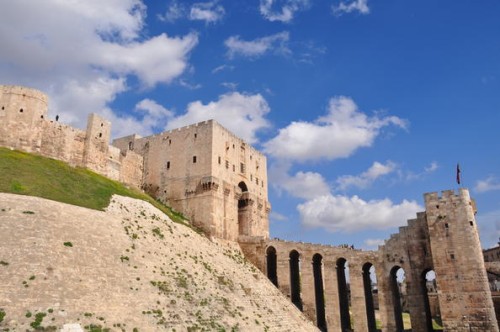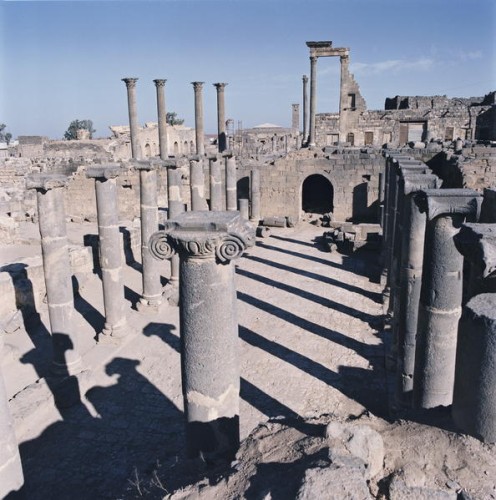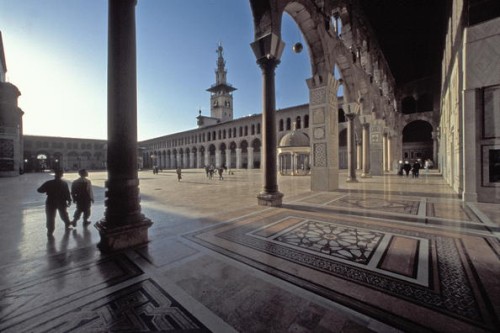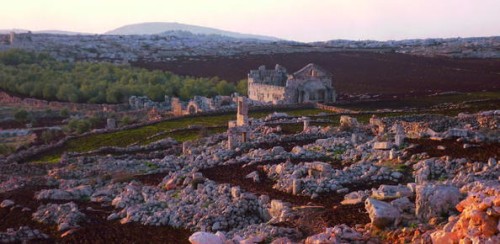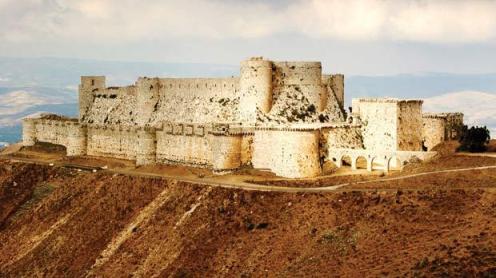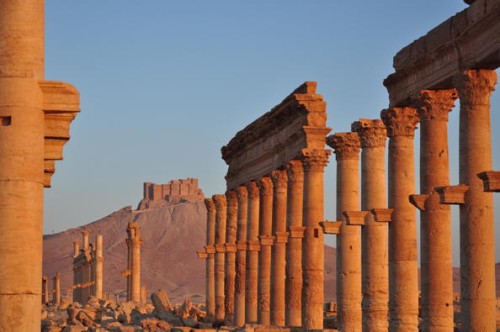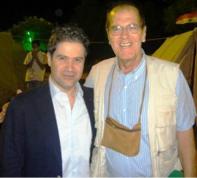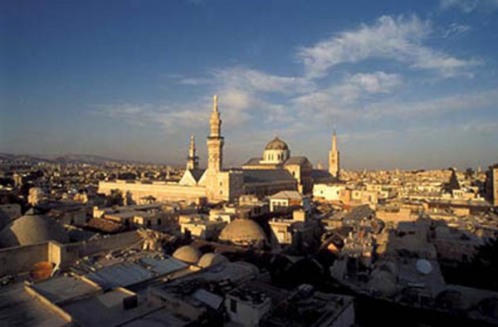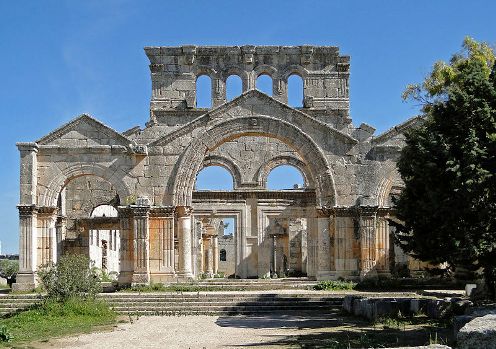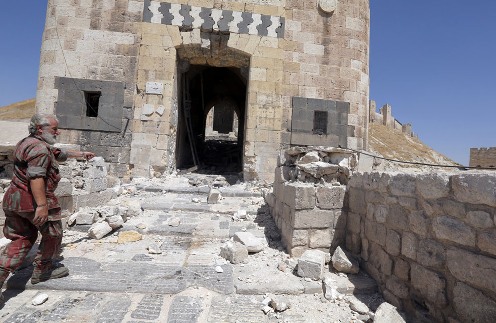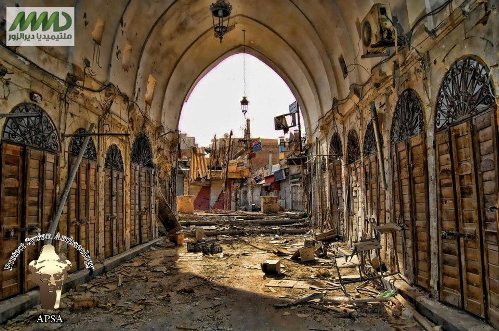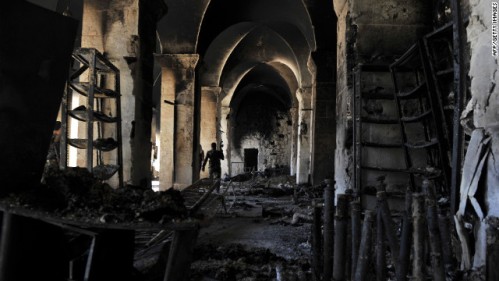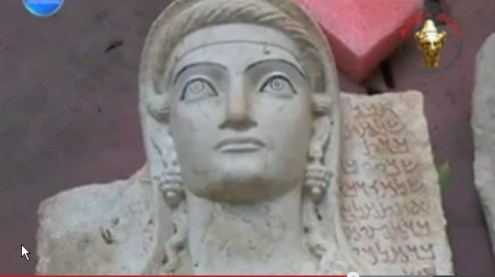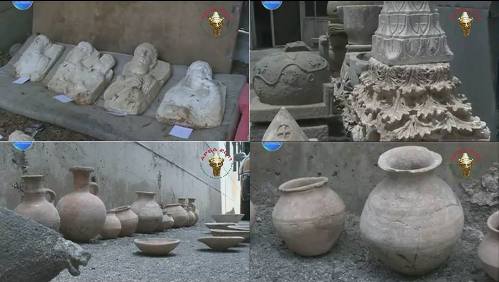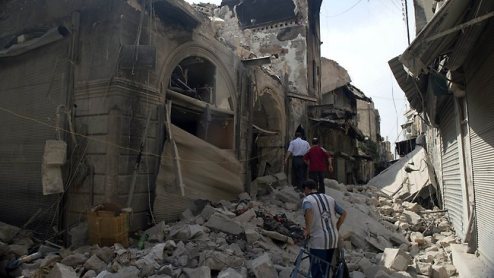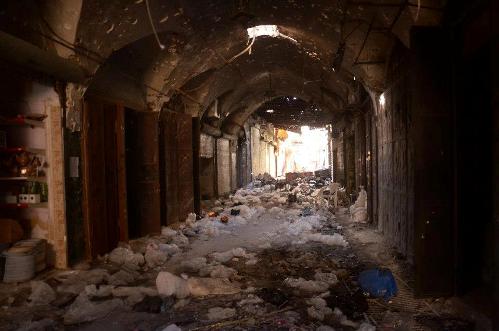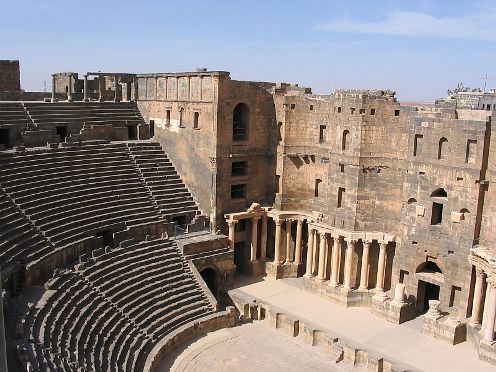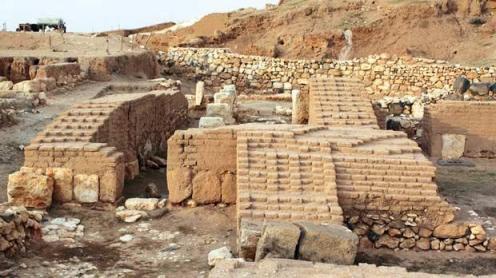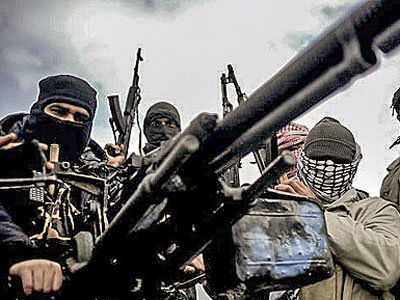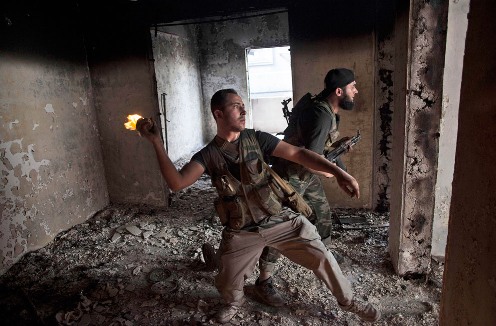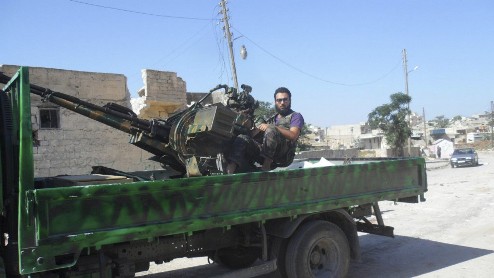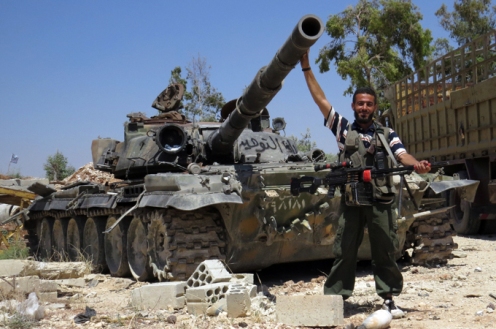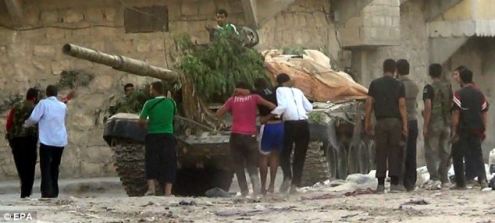|
Updated September 29, 2013 Introduction Who can forget the pillaging and destruction of Iraq's National Museum of Antiquities in 2003. We remember well watching the U.S. Marines on television, guarding and protecting the attack on the museum, turning blind eyes from the thieves. We remember how under their watch, some grand statues could only be loaded with cranes onto tractor trailers before being hauled off by the barbaric invaders. At that time Dr. Afnan Hussein Fatani, Professor of Stylistics at King Abdul Aziz University wrote:
This article and photo/video essay tells of the destruction of ancient sites and looting of antiquities in another part of the Cradle of Civilization, Syria. This crime is resulting from the foreign invasion of the terrorists of al-Nusra, al-Queda and other mercenaries injected into the country by the US, France, Israel and Arab puppets of the west such as Saudi Arabia and Qatar. Franklin Lamb describes some of the destruction and the Syrian government's heroic preparations for reconstruction in the midst of war, plans to be initiated by "a new generation of Syrians." The author also gives evidence of President al-Assad's encouraging structural changes and introduction of new leaders in government from all sectors of Syrian society. For this we can thank al-Assad for his intelligence and courage to open doors to and share power with critics and potential enemies. There can be no doubt that these changes are not a result of US belligerence as Washington and their corporate media would have us believe. This revitalization of Syrian society in the midst of a foreign invasion is also due to the support and wise diplomacy afforded by Russian President Vladimir Putin who has brought new hope to the Middle East and indeed, the world. Following Lamb's report, Axis of Logic provides a photo/video
essay of some of the historic sites that have been damaged or are at
risk. The western media consistently and erroneously places blame on
shelling and aerial bombing by the Bashar al-Assad government for the
devastation. There is no doubt that Syria is at war and President Bashar
al-Assad has stated repeatedly that routing the foreign invaders from
heavily populated areas tragically results in damage to buildings and
civilian injuries and deaths. However, western media depicts "the rebels" as an
undergunned, rag-tag bunch of "protestors," incapable of the level of destruction that is taking place. The photo/video essay below Mr. Lamb's article shows
otherwise and the final video is most telling. Photographs of victims of the war are intentionally omitted out of respect for them and their families. - Les Blough, Editor
Passing the Torch to a New Generation of Syrians Few, one imagines, in the Syrian Arab Republic these days question the urgency and enormity of the task of reconstruction of their ancient country from war inflicted destruction caused by a carnage already more than half as long as World War I and approaching half as long as World War II. For this ten millennium civilization and its thousands of priceless treasures, many partially destroyed, emergency efforts are needed today to preserve and protect the structures from thieves and war damage. Not many here would disagree with this priority of the Syrian government. Historic sites damages or in danger include several among those listed on the UNESCO’s World Heritage List registry including the Ancient City of Aleppo (1986), Ancient City of Bosra (1980), Ancient City of Damascus (1979), Ancient Villages of Northern Syria (2011), Crac des Chevaliers and Qal’at Salah El-Din (2006) and the Site of Palmyra (1980). Centuries-old markets and archaeological treasures have already been gutted by flames and gunfire in places like Aleppo and Homs.
Examining and discussing in Syria and Lebanon, some of the assessments of damage now being painstakingly documented, as well as pursuing some summaries of the data and analysis from on-the-scene government investigators, it is clear that plans for reconstruction at the earliest possible opportunity are being readied. Taking the lead, and poised to help, is the Syrian population as well as officials exhibiting pent up kinesis waiting to be released at the first sign of a credible cease fire so as to begin to rebuild their country. Reconstruction of Syria will be aided by three regime reshuffles since the beginning of the March 2011 uprising, which has infused much ‘new blood’ into the Syrian government. This process includes more than 20 changes at the ministerial level in recent months, in some cases replacing well entrenched and influential, if slightly fossilized, political operatives with overboard government roles from decades past. The bold reformist initiative is designed to reshuffle the corridors of power and have one claimed goal: To push and achieve reform. More than a few officials have advised this observer of their deep convictions and their commitments for reforms which they note are spreading inside as well as outside government.
Last month’s most recent infusion of 7 Minsters, known for their competence not political pedigree, include several ‘independents’ intended, according to one adviser to Syria’s President Assad, to bring much needed new blood and energy to the leadership. Their mandate is to face the current challenges straight on while eschewing entangling perceived political obligations from the past. These ‘best and the brightest’ are being empowered here to help rebuild Syria, it was explained to this observer by two university professors as being a government priority but without the American best and brightest noblesse oblige arrogance and fascist tendencies of the Bundy brothers and McNamara’s ‘whiz kids’ from the 1960’s. The most recent changes have included bringing in the following gentlemen (why no women!) who are known for their competence rather than simply as stalwarts of the ruling Baath party.
One of the “new breed” of Syrian public servants is Bishr Riyad Yazigi, a non-Baathist, independent Member of Parliament, who appears beholden only to his vision of restoring Syria and its vital tourism industry, as part of rebuilding his country, and for which he was appointed Minister on 8/22/13. Minister Yazigi, who I first met up on Mount Quisoun a several weeks ago, is distinctively Kennedyesque in his good looks, charm, vigor, progressive ideas and charisma. A businessman, born in Aleppo in 1972, is currently the youngest member of the Assad Cabinet, land like others, is not a Baath Party member. He holds a Bachelor’s degree in Informatics Engineering from Aleppo University (1995) and is an independent member of the People’s Assembly (Syrian Parliament) for Aleppo city. He is married and has three children. Yazigi is reputed to spend these days often working around the clock to rebuild Syria’s tourist industry.
Earlier this month, Minister Yaziqui stressed to a gathering of “Loyalty to Syria” members anxious to start rebuilding their country, the importance of NGO’s in revealing the reality of events in Syria to global public opinion and pledged to work with them to present the image of Syria as a tourist destination given its richness with historical and religious monuments. Meeting members of “Loyalty to Syria” Initiative, he pointed out that the Tourism Ministry is working to show the image of Syria as a tourist destination of unparalleled richness of historical and religious monuments and that all Syrian must redouble their efforts to achieve their goals of “boosting the social values and developing national capacity to serve the best interest of Syria.” The Syrian reformers tasks are daunting. Yet so were those, admittedly on a smaller scale, that faced Lebanon following 33 days of near carpeting bombing by the Israeli government employing, as they have done for more than three decades, a vast array of American weapons gifted by American taxpayers with neither their knowledge, consent nor opportunity to object. The cost of rebuilding Syria is perhaps incalculable. The Syrian government announced this week that it has earmarked 50 billion Syrian pounds ($250 million) for reconstruction next year in the war-torn country. For 2013, the figure was 300 billion Syrian pounds. ($ 1.2 billion). But these sums are a drop in the bucket. According to Syrian real estate experts, including Ammar Yussef, if the war in Syria suddenly stopped and reconstruction began today, around $73 billion would be needed to put the country back on track. Yussef, insists that the bombings, fighting and sabotage of infrastructure during the conflict has as of August 30, 2013, partially or completely destroyed 1.5 million dwellings. If the rebuilding were to start today, led by the new ‘reform team’ it would include rebuilding more than 11,000 sites, some being full blocks, requiring 15,000 trucks, 10,000 cement mixers and more than six million skilled workers. A U.S.-educated economist, Abdullah al-Dardari, now working with Beirut-based UN development agency, claims that more than two years of fighting have cost Syria at least $60 billion and caused the vital oil industry to crumble. A quarter of all homes have been destroyed or severely damaged, and much of the medical system is in ruins. Al Dardari’s team estimates the overall damage to Syria’s economy, three years into the conflict, at $60-$80 billion. Syria’s economy has shrunk by about 35 percent, compared to the 6 percent annual growth Syria marked in the five years before the conflict began in March 2011. The economy has lost nearly 40 percent of its GDP, and foreign reserves have been extensively depleted. As noted above, unemployment has shot up from 500,000 before the crisis to at least 2.5 million this year. The fighting has destroyed or damaged 1.2 million homes nationwide, a quarter of all Syrian houses, al-Dardari claims. In addition, around 3,000 schools and 2,000 factories have been destroyed, and almost half of the medical system — including hospitals and health centers — is in ruins. Before the uprising, the oil sector was a pillar of Syria’s economy, with the country producing about 380,000 barrels a day and exports — mostly to Europe — bringing in more than $3 billion in 2010. But the vital industry has buckled as rebels captured many of the country’s oil fields, setting wells aflame and looters scooping up crude. Exports have ground practically to a standstill as production has dwindled. Syria does have vital labor resource to perform high quality reconstruction and her workers are ready to begin today given that the current unemployment in Syria noted above, according to this observers’ interlocutors at the Ministry of Economic Affairs and Industry. Syrian workers are perhaps the best and most reliable in the world. Well known for building and maintaining Lebanon and the Levant, even though currently paid one half to one third what less productive nationals receive. Despite the enormous challenges, there appears some light on the horizon if those governments involving themselves in the Syria crisis and wringing their hands at the toll of human misery and destruction, will achieve a permanent ceasefire during the current thaw in serious communications. The new generation of officials entrusted with Syria’s salvation and reconstruction appear to be in place and are anxious to be allowed into the war zones. The politician’s duties are to open their paths without further delays Franklin Lamb volunteers with the Sabra-Shatila Scholarship Program (SSSP) in Shatila Camp (www.sssp-lb.com) and is reachable c/o fplamb@gmail.com Source: Counterpunch
Axis of Logic Photo/Video Essay At a UNESCO-sponsored workshop in Amman, Jordan, Maamoun Abdulkarim, head of the Syrian government's antiquities department, warned regional antiquities directors, customs and police officials, and international protection agencies of the smuggling of stolen artifacts. He urged a resolution by the UN Security Council to ban trade in stolen antiquities, specifically from Syria to preserve the nation's cultural heritage. Abdulkarim told Associated Press,
Artifacts already stolen from Syria include an 8th century B.C. Aramaic bronze statue with gold overlay taken from the Hama museum and it is now listed by Interpol. Byzantine mosaics from the Roman city of Apamea near Aleppo were also bulldozed and removed. It's interesting that some of the stolen treasures turned up in Jordan as destination or a transit point to another country. Abdulkarim praised Jordanian police for their recovery of some items which included clay pottery, figurines and other undated artifacts. He asked UNESCO to appeal to Turkey and Iraq to enact stricter measures to prevent the smuggling of artifacts across their borders. He also warned that Syria could become another Iraq, "We don't want the world to go through the Iraq experience again."
The government-controlled media of the west shows photos of destroyed and damaged buildings, consistently blaming the destruction on shelling and bombing by the Syrian government. Below are some of the heavy arms supplied by US-backed Saudi Arabia, Qatar and other western puppets. One can imagine the indiscriminate shelling done by foreign mercenaries with these arms, not to speak of the damage done as they hole up in these ancient sites, using them as shields against government attacks.
The terrorists also use barrel bombs and car bombs to kill and destroy. Two days ago a "Syrian rebel bomb attack reduced the army headquarters in Damascus to a smouldering wreck today as world leaders, unable to break the diplomatic deadlock in the conflict, met at the United Nations." according a report by The Independent (UK). And this 29 second video shows they are in possession of powerful C-4 explosives being supplied to them by other countries:
This video was filmed of a convoy of tanks in rural governante of Rif Dimashq outside of Damascus, home to the administrative headquarters of Rif Dimashq. It should be obvious that these tanks were supplied by foreign governments.
The final video in our report shows the terrorists destroying a historic shrine dedicated to the prophet Abraham declaring it to be a place of heresy and idolatry. Radical Wahhabis Bulldoze Historic Mausoleum of Eretz Zen writes: From May 16, 2013: A radical Wahhabi group affiliated with al-Qaeda's Jabhat al-Nusra (Nusra Front) is seen surrounding and then destroying with a bulldozer a historic mausoleum or shrine visited by pilgrims dedicated to the prophet Abraham, who supposedly spent some time with his wife Sarah in the town of Ayn al-Arous where the shrine was built. Ayn al-Arous is located south of Tal Abyad in the Raqqa province in northern Syria. The person filming the scene refers to the shrine as containing heresies and being worshiped besides Allah without specifying who exactly worshiped the edifice. This practice of destroying tombs and shrines is nothing new for the al-Qaeda Salafis, for they are currently practicing the same type of behavior in Tunisia, Mali, Afghanistan, Somalia, etc.
Conclusion The damage and in some cases the destruction of Syria's ancient buildings, towns, cities and artifacts are directly attritutable to the foreign invasion of the terrorists of al-Nusra and al-Queda and their sponsors in the US, France, Israel and US-backed Arab dictatorships. Responsible governments defend their people with force as al-Assad has done when foreign invaders enter a country and attack civilians, infrastructure, civil institutions, police and the military personnel. It is hopeful and admirable to see the Syrian government simultaneously laying plans to protect their ancient heritage and rebuild the country while driving out the invader. The world may be finally "turning a corner" away from 12 years of US/NATO wars, destruction and human misery. This "turning away" began when one world leader, Vladimir Putin drew his own red line with wise diplomacy, backed by the only force the belligerents understand - an unspoken but known military capability. Biography,
Essays
and Poetry
by Les
Blough |
